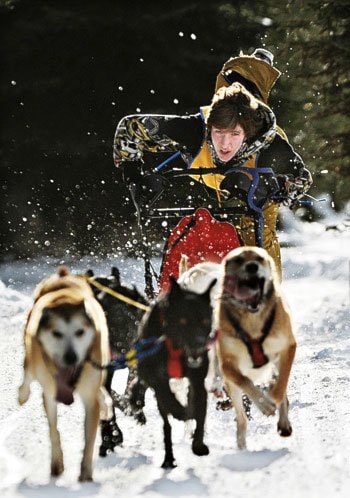Anyone who keeps up with the expediton’s blog likely notices that a certain phrase has been repeated: “expect the unexpected.”
The unexpected is a constant visitor in everyday life, but for Yukon adventurers Devon McDiarmid, 34, and Derek Crowe, 34, and British companion Adrian Hayes, 44, the unexpected can be life threatening.
As of Sunday, the trio of adventure seekers have travelled just short of 2,200-kilometres from the south of Greenland, climbing 2,643 metres in altitude on ice sheet and feeling “like sailors on a frozen ocean,” as put by Hayes on their blog.
Thirty-six days ago the three set out on what was estimated to be a 65-day trip, using large parachute-like sails to be the first to kite-ski from the southern tip of Greenland north to the top and partially back down again, not once being re-supplied along the way.
As they have learned, relying on wind for transportation leaves a lot of room for the unexpected.
“It may be the summer solstice, the longest day of the year, but, having equaled our record daily distance of 185 kilometres Saturday, we achieved our shortest daily distance today—less than 200 metres,” writes Hayes on Sunday. “Those wondering why we bothered to get out of our tent—very good point. For the record, the wind died just as we launched our kites.
“The big thing we came to Greenland thinking was that we would be kiting on nice, even, strong katabatic winds from the east. This however, has not been the case and we have had primarily light winds from the south. This is not ideal. Almost too light and from the wrong direction. Luckily we were given some good advice from a fellow expedition member who has been here before whose main tip was ‘bring a kite for low winds.’”
The quickest route to their final destination is not a straight line, but, instead, a course that takes them more west where they can harness Greenland’s katabatic winds and avoid climbing an extra 3,000 metres in altitude.
However, two weeks ago, the trio had little to choose from, riding softer winds more toward the east than they had planned.
“Non-kiters/sailors might assume the best winds we can have are from the south,” wrote Hayes on June 12.
“However, unless they are very strong, our optimum winds are from the east or west. This hits a kite from the side and propels the fastest forward motion.”
As can be expected with an undertaking of such magnitude, course correction is not their only concern.
After taking more time than expected reaching the top of the Greenland glacier at the start of the trip, and since running into difficulties harnessing consistent winds, food supplies are becoming more of a factor.
“Last I checked they were about halfway up, but that’s not half of the whole trip, and apparently they’ve burnt through half their food,” said Jonah Clark, a friend of McDiarmid. “The plan is once they reach the Arctic Circle they’ll move faster.”
To add to those concerns are raising issues with their equipment. But, for the most part, they are pleased with how things are holding together.
“We have had a battery pack terminally fail, some kite lines damaged, destroyed food from the pulks bashing over the Sastrugi at 30-kilometre an hour, small tent damage and some aches and pains,” wrote McDiarmid on Friday. “All of which we have been able to fix, replace or simply make do—we have no luxury of being re-supplied.
“So far we have been pleasantly surprised for the most part. Our equipment is working well, food good, bodies in good shape and making the miles we need.”
Despite all the obstacles and detours, the trio is making better time in recent weeks and are now looking to finish ahead of schedule, said Crowe’s wife Jane Koepke.
“(My husband) told me that they’re estimating that they’re going to take 50 days, give or take five, which would have them finish between the 10 or 15 of July,” said Koepke. “I don’t really have the chance to have very in-depth conversation over the satellite phone, but as of last week they were estimating 50 days.
“The snow conditions are improving a lot since they crossed the Arctic Circle.”
Besides seeking adventure, the three explorers are seeking information for scientific research and are hoping to raise awareness about climate change. Working with an environmental group called One Planet Living and some Danish and Canadian polar researchers, the trio will collect samples, do tests and observe wildlife on the journey.
“As to our ‘quest’, the whole message we are conveying throughout is to hammer home the complete link between a melting ice cap, global warming, the environment, society and the economy,” writes Hayes. “The message of sustainability and the action plan of BioRegional’s One Planet Living.”
Every five days they take a sample from the bottom of a hole they dig and weigh it to determine its density.
Although they are taking measurements in areas scarcely visited by humans, the team is not expecting to find any earth-shattering results.
“Those expecting us to come out with headline-grabbing conclusions will be disappointed,” writes Hayes. “The data is one of a wealth of information from various sources and factors that will get pooled into the complex monitoring programs to provide both facts and projections relating to the Greenland ice sheet and global warming.
“What the data we provide does give is accurate on the ground information not easily available elsewhere. And the more information our scientists can have, the more accurately they can predict both what is happening to this majestic land of ice—and project what could/will happen in the future.”
People can follow their progress at www.greenlandquest.com.
Contact Tom Patrick at
tomp@yukon-news.com
